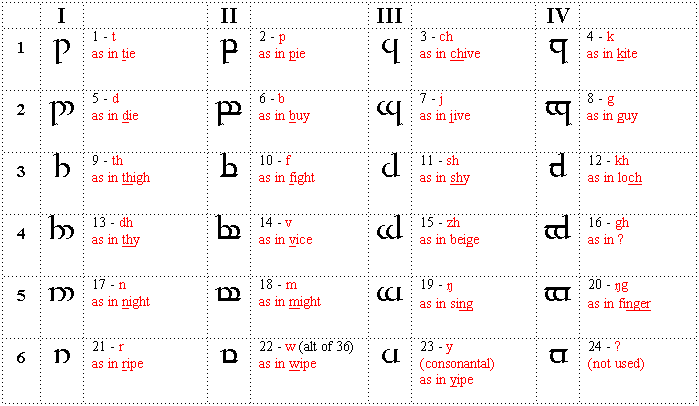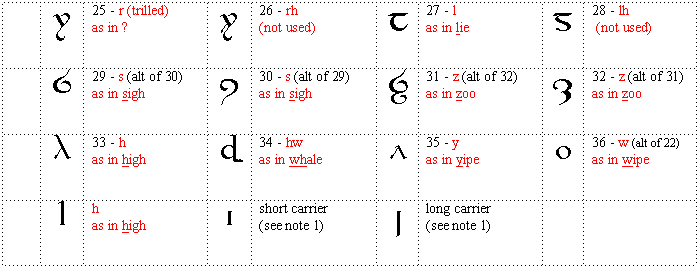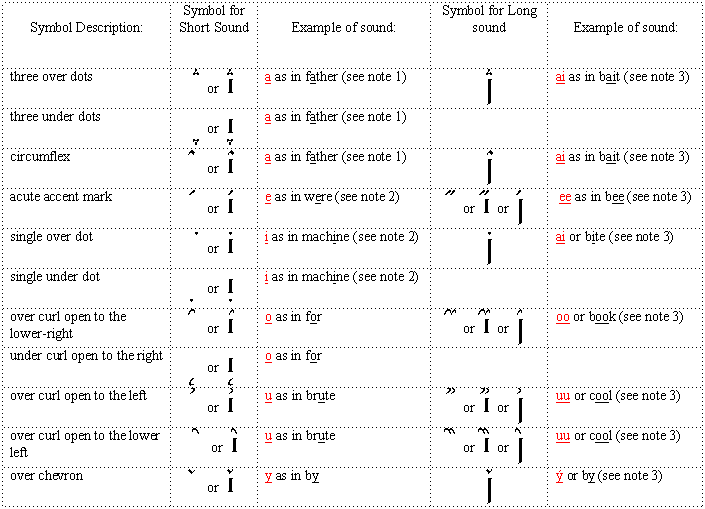
Below is a table containing the Tengwar letters and their English values:


| 1) | The long and short carriers are silent letters. They are used in conjunction with vowel symbols. |
Below is a table containing the Tehtar symbols and their English values:

| 1) | In "The Lord of the Rings" title page inscription, three dots are consistently uses to represent the a sound. But in Appendix E of "The Lord of the Rings", Tolkien states that the circumflex symbol can also be used to represent the a sound. |
| 2) | In "The Lord of the Rings" title page inscription, J.R.R. Tolkien used the acute accent mark for the e sound and the single over-dot for the i sound. But in the "Silmarillion" title page inscription, Christopher Tolkien consistently used the reverse (acute accent mark for the i sound and the single over-dot for the e sound). The Tehtar values in this chart correspond to J.R.R. Tolkien's "The Lord of the Rings" title page inscription. |
| 3) | Long vowels, as Tolkien described them, do not exist in the English language. Instead, English uses diphthongs, or blend of two vowel or semi-vowel sounds. Due to English orthography, short and long vowel sounds often do not share the same base vowel. An example: the short a sound is a as in father, while the long a sound is ei as in eight, rather than ai as in bite. |
In Appendix E of the "Lord of the Rings" Tolkien explains that there is no official mode for using Tengwar with the English language. But on the title page of the same book Tolkien gives an example of an English phrase written with Tengwar "in the Westron mode as a man from Gondor might write it". This is the mode that will be discussed here.
It appears that Tolkien adapted the Westron Mode to create a version of Tengwar for use with English. The phonetic values assigned to each Tengwar letter and Tehtar symbol is similar to the Sindarin Standard mode. Also the rules for writing are the same for English as they are in Sindarin, with the Tehtar placed above the next consecutive Tengwar letter. To read English/Tengwar script you would read each Tehtar vowel symbol, then the Tengwar letter below it (in a downward motion), before going on to the next Tehtar/Tengwar letter combination. The primary innovation that Tolkien demonstrates is the use of additional letters to be used as shorthand for commonly used words.
In the "Lord of the Rings" title page inscription the following additional letters are used:
These commonly used words are used several times in the "Lord of the Rings" and "Silmarilion" title page inscriptions:
Source:
"The Lord of the Rings" by J. R. R. Tolkien
Volume III, "The Return of the King", Appendix E
Houghton-Mifflin
ISBN 0-395-27221-1
"Silmarillion" edited by Christopher Tolkien
Houghton-Mifflin
0-395-25730-1
|
Back to Main page. Last updated: November 2, 1999 |
Copyright © 1995-1999 Daniel Steven Smith Frequently Asked Questions |